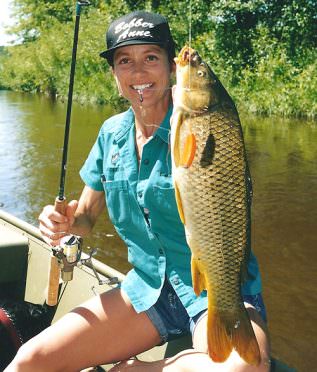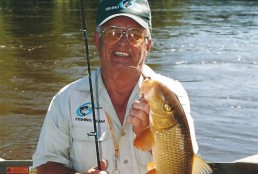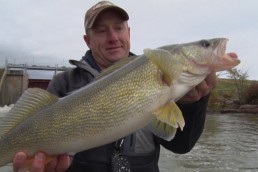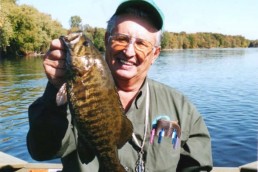Bottom-hugging River Ruffians Tasty on the Table
SHARE THIS POST
So-called ‘rough’ fish must be tricked into holding on
Hi, “Bobber” Anne here, and before my partner, the ol’ Man, gets into the heart of this article, I’ll let him tell you a tale of his youth, one that I’m sure most of you haven’t heard.
So Dan, take it away…
Thanks, Anne! This is a tale of something that took place 75 years ago in the forested regions of northern Ontario, that repeated itself every fall. It’s a tale of suckers and sleigh dogs.

Until I was 21 years old, my family lived on the famous Nipigon River. There, we ran a fishing resort in the summer, made fishing tackle in the winter, and I ran a team of sleigh dogs over a trapline. I made my spending money from an early age by trapping furs and tying flies in the fly shop. My dog team experience began at the age of 10 and ended during my 17th year.
What does that have to do with this column? Let me explain. With six dogs to feed through the winter, my father came up with an ingenious idea. He’d buy several 100-pound sacks of oatmeal each fall. Each sack cost about $2. This oatmeal would be the base of our dog food. Suckers would be the protein to enhance the meal.
The fall sucker run up Mission Creek would provide 200 to 250 brown suckers. These would be axed up into three pieces and dropped into a 55-gallon drum, which already had a mixture of oatmeal and water heated up to boiling. Once all had been cooked to Father’s approval, the barrel mix would be poured onto a table with four-inch-high sides and left to freeze solid.
Once frozen, the mix would be hacked into single-dog portions. These would be stored in the guides’ fish-cleaning shack. Being that we didn’t have today’s ice drills, ice fishing was a thing we only tried in November and early December. After that, with only iron spuds to cut holes, no one thought of ice fishing. However, we did have fish throughout the winter thanks to my mother’s ingenuity.
Almost forgot–we captured these fish in landing nets as well as spearing them with homemade metal spears. During these catches, we often encountered redhorse. These were always saved for my mother to make winter fish patties from. Yup, redhorse were our staple winter eating fish. Sound bad? On the contrary, those patties were delicious. If you’ve ever filleted a redhorse, you’ve seen that the meat is ivory white and flaky. The only problem is the feather bones branching out from the fish’s ribs.
Making redhorse patties
First, I filleted the redhorse as I would a walleye, removing its skin and rib bones as I do on any fish. Next, I was instructed to cut the fillet into three long strips. At this point, my mother would take over. Using a hamburger grinder, she would run these strips through the grinder––twice––to finely chop the feather bones.
Then the ground fish was patted into eating-size ‘burgers’ to be frozen in our outside fish house. When needed, they would be brought in to be fried for a winter treat. That pure white meat was delicious and there wasn’t a bone to be found.
Arriving at the point
It’s “‘Bobber” Anne back with you, and finally, time to begin the tale of rough fish in the Benthic Zone. Let’s go out on the water, during an outing intended to capture underwater video that would show how fish react to what was at the time a prototype lure, one that has since come to market, called the Spin Bee. Dan and I were anchored in 4 feet of water in one of our favorite spots, when I noted a good-sized carp approach the 1/16-ounce Spin Bee we had attached to the video camera’s underwater rig.
“Let’s see if old pucker mouth will take the bait,” commented Dan, as I was keeping him informed of what I was seeing on the monitor.
We had added a Red Ball egg to the lure for scent. This would be a good test. Slowly, the carp finned closer to the Spin Bee, which hovered just off bottom, its tail spinner flicking from side to side. It appeared that the fish had picked up the anise scent of the red ball egg. Then, as anticipated, the Spin Bee was sucked into the carp’s mouth.
Before Dan had a chance to set the hook, the mouth opened again and the bait was blown back out.
Are you enjoying this post?
You can be among the first to get the latest info on where to go, what to use and how to use it!
“Hey, why didn’t you set the hook?” I asked Dan.
“Because I didn’t feel a thing,” came his reply.
We came to the same conclusion, that the weight of the lure had been detected, thus the rejection. Next came a hog-nosed sucker, then a redhorse with similar results. Several smallmouth bass and rock bass had been taken and released between sucker strikes, but these were the general rule for the new lure. We were interested in the rough fish. If we could create a lure that would take a rough, a whole new world would be opened to the angling public.
“Anne, I got it,” Dan said at one point. “Let’s try the 1/32-ounce size. That might do it.”
Dan had been telling me that North America holds 56 species of suckers and 4 species of carp. Already we have carp clubs, and what if more anglers became excited about “rough fish” fishing? Good Lord, what a bonanza for the angling public to tap into. Especially if they found out what a fighter the redhorse is, and what a stubborn fish the hog-nose and white sucker are to land. Sprinkle in Dan’s mother’s recipe for preparing redhorse and imagine the enjoyment (on the water and at the table) we could all find. We might even see sucker and carp tournaments pop up.
Sorry, you bass lovers!
Birth of something new
During the last week of September a few years ago, we were back on one of our favorite stretches of Mississippi River water, again testing the 1/32-ounce Spin Bee on what other people call rough fish. This was during a time when we were hard at work refining our knowledge of what we have come to call Benthic Zones, which are slack-water areas on river bottoms, rising higher than what previous generations realized. (We have written extensively about Benthic Zones here in MidWest Outdoors.)
Most of the river’s carp and suckers are to be found in the Benthic Zone, something that we knew well by this time. Our hopes, by using a 1/32-ounce Spin Bee, were to lighten the weight of the lure so the fish wouldn’t spit it out after taking it in. We knew the fish would be attracted to the lure, and believed the tail spinner was a big factor.
During the previous 4 years of testing, we had taken several carp and a number of suckers, but about 90 percent of strikes from our pals the rough fish had resulted in blow-backs, where they spit the bait out after taking it in for a fraction of a second.
Once I attached a 1/32-ounce Bee to Dan’s line and started watching the underwater camera feed, the bait was instantly attacked by a school of bluegills and crappies–this wouldn’t do. We needed to move, maybe a lot deeper, toward the river’s main channel. There, we might find deeper Benthic Zones, in which we’d stand a better chance to find rough fish.
Fifty feet out from where we started, we found our target fish. A school of redhorse came into view on my monitor. Two of them instantly swept toward Dan’s small Spin Bee. Then, as many of their relatives had done previously, one sucked the small Bee in. Dan set the hook and instantly the fish went airborne, sending the little bait sailing into the air.
That was a better result, but more testing was called for. That fall day proved somewhat of a success. We had a 50 percent hookup rate on suckers and 60 percent on carp. Even though the bait was light in weight, we believed our hookup rate could be greatly improved with a new design.
Dan took to drawing ideas and making prototypes intended to overcome the problem of these fish spitting out the bait before you can set the hook. During the early stages, I heard him mumbling about how those fish were not going to win this war, and something about eating his hat if his new idea didn’t work.
The main thing I can tell you right now is that Dan’s hat is still on his head. And we have something very exciting to tell you about in upcoming issues of MidWest Outdoors.
This is “Bobber” Anne, on behalf of the ol’ Man, and we’ll see you soon for more on a new system that will have you catching a lot of fish that others don’t value highly enough. You can be out there battling them, and bringing ‘em home to grace your dinner table.
MWO
SHARE THIS POST
Did you enjoy this post?
You can be among the first to get the latest info on where to go, what to use and how to use it!
'Bobber' Anne Orth
Known in the fishing world as ‘Bobber’ Anne, she has co-hosted countless TV fishing & hunting shows, throughout the Americas, since 1991. Her primary efforts include filming fish strikes on underwater video, giving family seminars, writing articles, and conducting sales for Gapen Tackle Company. In 2018, she was inducted into the National Fresh Water Fishing Hall of Fame.



